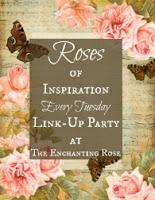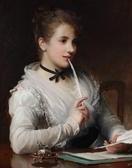Quest'oggi il viaggio che vi invito a compiere nel passato è più lungo del solito, ci spingiamo più lontano nel tempo ovvero nell'Inghilterra del periodo Georgiano (XVIII° secolo, ovvero dall'ascesa al trono di Re Giorgio I -1714 - alla morte di Re Giorgio IV -1830) per 'assaggiare'
LA CIOCCOLATA DEI RE,
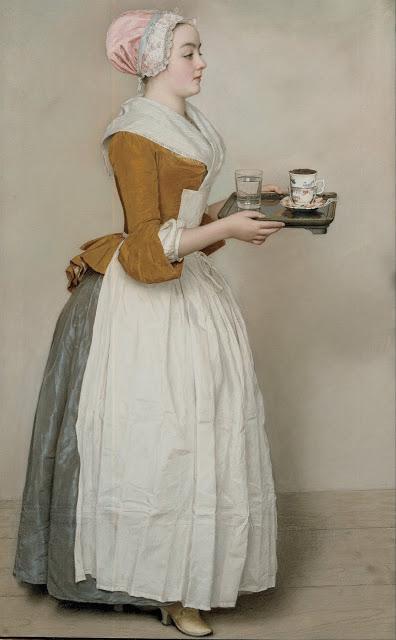
The Chocolate Girl o La Belle Chocolatiere by Jean-Etienne Liotard, c1744
come tempo fa vi promisi.
Se ricordate, 'girando' per Hampton Court Palace (♚ NOBLE MANSIONS AND CROWNS ♚ Queen Mary II & Hampton Court Palace and Gardens. ) ci trovammo a curiosare nelle CHOCOLATE KITCHEN, stupiti nel constatare l'esistenza di un vano appositamente preposto per la preparazione della cioccolata calda, dei dolci a base di cioccolata e della conservazione dei medesimi, in una sorta di spazio asettico accuratamente scelto in base alle sue caratteristiche in quanto a temperatura ed umidità, rigorosamente costanti nelle varie stagioni dell'anno, arredato con i tipici attrezzi del cioccolatiere.
Addentrandoci nella storia di questa bevanda che ci delizia soprattutto durante le giornate più fredde dell'inverno, scopriamo che a partire
dal 1600 la cioccolata calda veniva servita nei locali pubblici, come oggi lo è il caffè, ma era prestigiosa come oggi può essere considerato lo champagne, ed ogni re aveva il suo cioccolatiere di corte, il primo dei quali fu Thomas Tosier, cioccolatiere ufficiale di Re Giorgio I.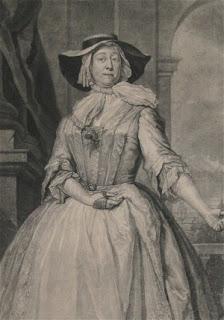 Dovete sapere che Thomas aveva una moglie molto intraprendente, Grace, una donna allegra e di buon carattere, la quale, mentre il marito lavorava per il re di Hampton Court Palace, pensò di avviare a Greenwich una Chocolate House, ossia una cioccolateria.
Dovete sapere che Thomas aveva una moglie molto intraprendente, Grace, una donna allegra e di buon carattere, la quale, mentre il marito lavorava per il re di Hampton Court Palace, pensò di avviare a Greenwich una Chocolate House, ossia una cioccolateria.Durante tutto il XVIII° tale tipologia di locale pubblico conquistò sempre maggior successo per giungere a divenire un luogo eccelso per le classi superiori in quanto sinonimo di lusso, raffinatezza e buona compagnia e Grace era così accorta da riconoscere che collegare tale bevanda così ambita con il nome dei Tosier e soprattutto quello del re poteva fare la sua fortuna, e così fu, addirittura tale fu il suo successo che alla morte di Thomas ella contrasse un secondo matrimonio, ma conservò il cognome Tosier, tanto era divenuto rinomato e legato alla storia della cioccolata calda in tazza.
La cioccolateria era un locale dove si discuteva di politica ed economia, questo perché era frequentato solamente da uomini essendo tale bevanda considerata molto stimolante - in quanto il cacao provoca una scarica di endorfine e zuccheri a livello ematico - e perciò non adatta alle ladies cui una tale eccitazione avrebbe indotto un disagevole e sgradevole tremolio alle mani.
E veniamo all'originale ricetta della cioccolata calda che ogni giorno, anzi, più volte al giorno, Thomas Tosier preparava per il suo re:
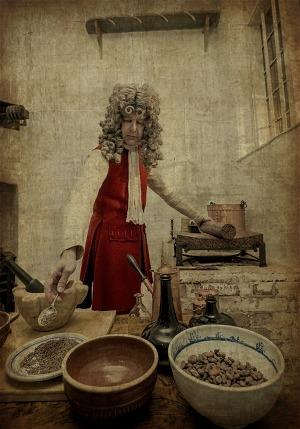 il compito più arduo e più faticoso era quello che spettava al garzone che affiancava il cioccolatiere, ovvero al ragazzo di cucina, poiché era lui che, con pazienza doveva tostare i fagioli, ovvero i semi del cacao al fine di poter rimuoverne il guscio che li riveste; questi venivano quindi macinati finemente su di un METATE ( antico attrezzo da cucina messicano che corrisponde ad una sorta di grande tagliere in pietra ) con l'aiuto di un matterello in pietra; sotto il Metate erano posti dei tizzoni ardenti in modo che la pietra risultasse infervorata e sia questo, sia la frizione e la pressione operata dal matterello riducevano i semi in un composto semiliquido.
il compito più arduo e più faticoso era quello che spettava al garzone che affiancava il cioccolatiere, ovvero al ragazzo di cucina, poiché era lui che, con pazienza doveva tostare i fagioli, ovvero i semi del cacao al fine di poter rimuoverne il guscio che li riveste; questi venivano quindi macinati finemente su di un METATE ( antico attrezzo da cucina messicano che corrisponde ad una sorta di grande tagliere in pietra ) con l'aiuto di un matterello in pietra; sotto il Metate erano posti dei tizzoni ardenti in modo che la pietra risultasse infervorata e sia questo, sia la frizione e la pressione operata dal matterello riducevano i semi in un composto semiliquido.Il cioccolato così ottenuto veniva fatto cadere su carta oleata e suddiviso in cialde che venivano conservate per l'occorrenza; quando venivano prese, sciolte con acqua, latte oppure vino - il re esigeva rigorosamente il Porto - ed il composto liquoroso che ne risultava veniva quindi mischiato con zucchero e spezie esotiche quali la vaniglia, il cardamomo, l'anice, il 'Grano del Paradiso' ( conosciuto anche come melegueta o pepe della Guinea, sostituibile con il pepe nero ) e la 'Rosa di Alessandria'.
Pensate che le prime ricette risalgono al periodo Stuart (1603 -1714).
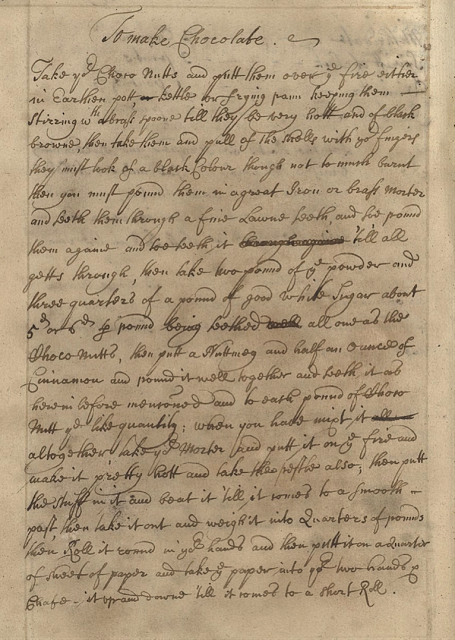
English medical notebook, 1575-1663 (Wellcome Library MS.6812, p.137)
Si legge in una pubblicazione del 1661, che pretende di svelare il segreto di 'come gli indigeni procedono', nelle Americhe, per fare quella che era soprannominata 'The India Nectar', che si tratta di una bevanda il cui colore è molto scuro, la consistenza è densa ed il sapore è dato da una complessa miscela di spezie che indugiano sulla lingua.
Ne deduciamo perciò che allora era molto diversa da quella che conosciamo noi oggi.
Hans Sloane fu il primo ad utilizzare il latte nella cioccolata calda intorno al 1700, ma eccovi nelle ricette riportate qui sotto come possiamo preparare più comodamente a casa nostra una cioccolata calda in tazza degna di un re:
CIOCCOLATA AL PORTOUna lussuosa bevanda, adatta per quando fuori fa freddo.
Ingredienti: per 4 piccole tazze∞ 40g di cioccolato fondente, contenente almeno l'80% di cacao ∞ 600ml di porto rubino ∞ 30g / 40g (2/3 cucchiai) di zucchero semolato∞ Un grande pizzico di farina bianca
Istruzioni:∞ Versare tutto il porto in una pentola.∞ Rompere il cioccolato in piccoli pezzi e aggiungere nella pentola.∞ Unire quindi lo zucchero. L'alcol diviene amaro quando si riscalda, perciò potrebbe essere necessario assaggiare più volte.∞ Spolverarvi la farina.∞ Cuocere a fuoco basso per 10 minuti, fino a quando si formano piccole bolle intorno allabordo. Non bollire.∞ Frullare il composto con il 'moulinet'.∞ Versare in coppette e servire mentre è ancora caldo.
CREMA AL CIOCCOLATO
Una ricetta per una cremosa salsa al cioccolato adattata da un libro di cucina reale risalente al 1716.
Ingredienti: per fare 8 tazze
∞ 1,2 l latte intero
∞ 115g di zucchero semolato
∞ 1 tuorlo d'uovo
∞ 70g cioccolato fondente ( con almeno l'80% di cacao )
Istruzioni:
∞ Unire al latte lo zucchero in una casseruola e mescolare.
∞ Cuocere a fuoco lento per 15 minuti, fino a quando lo zucchero si sarà sciolto.
∞ Sbattere il tuorlo d'uovo ed unirlo alla miscela.
∞ Fate cuocere a fuoco basso fino a quando la crema si sarà addensata, ma senza far bollire.
∞ Togliere la pentola dal fuoco e lasciare raffreddare per 5 minuti.
∞ Rompere il cioccolato a pezzetti e mescolarlo alla crema.
∞ Mettere al caldo a fuoco basso per un altro minuto. Continuare a mescolare per incorporare completamente il cioccolato ed impedire al composto di addensarsi.
∞ Versare in ciotole o tazze di porcellana. Servire e gustare la crema ancora calda.
Vi era allora, inoltre, un insieme di accessori particolari che erano necessari per servirla, ovvero per portarla dalla cucina alla tavola del re:
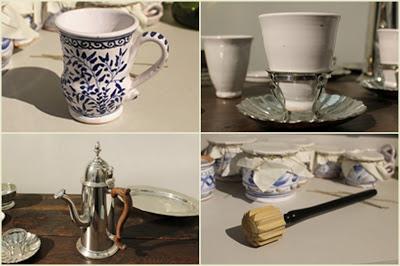
la cioccolatiera, che generalmente era in rame o argento, del tutto simile alla caffettiera ma con sopra il coperchio un altro piccolo coperchietto dal quale fuoriusciva il manico del moulinet, ovvero il mulinello in legno con cui bisognava continuare a mescolare la bevanda finché non fosse stata servita, al fine di amalgamarla bene ed anche renderla più cremosa, la tazza che era rigorosamente in ceramica, con o senza impugnatura, che doveva appoggiare su di una base di argento che la rialzava dal piattino, al fine di impedire che l'eventuale fuoriuscita del cioccolato ne sporcasse il fondo all'esterno (probabilmente le tazze venivano colmate fino all'orlo).
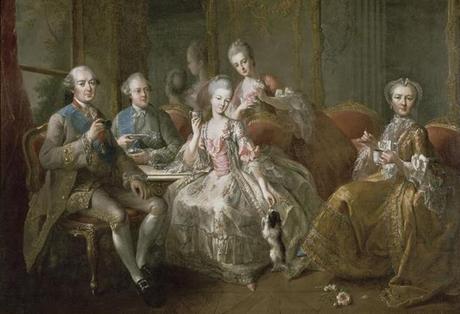
The family of the Duke of Penthièvre in 1768 o The cup of chocolate by Jean-Baptiste Charpentier
Ebbene sì, gli inglesi erano davvero molto ghiotti di cioccolata, ma questa costosa bevanda divenne da subito sinonimo di nobiltà e perciò consumata volentieri nelle regge e nei palazzi signorili dell'intero vecchio continente ... pensate che il naturalista, esploratore e botanico tedesco Alexander Von Humboldt (1769 - 1859), proveniente da una famiglia notoriamente aristocratica, sosteneva che
Tutto per colpa, o per merito, di re William III d'Orange, già sposo della cugina, futura regina Maria II Stuart, il quale arrivò in Inghilterra dall'Olanda nel 1689 recando con sé un grande amore per il cioccolato e, quale principe, egli aveva la possibilità di farsi inviare direttamente il suo cioccolato preferito direttamente dai Paesi bassi che avevano un consolidato collegamento commerciale con il Sud America.
Nella viva speranza di avervi intrattenuti dilettevolmente con questo argomento che da tempo attendevo di trattare e di avervi fatto trascorrere attimi piacevoli, vi abbraccio con affetto ed immensa gratitudine,
a presto ♥
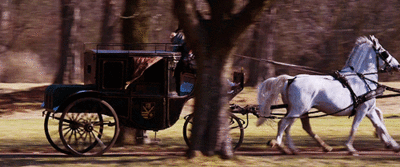

Fonti bibliografiche:
Sophie and Michael D. Coe, The True History of Chocolate, Thames & Hudson, 2013
About THE CHOCOLATE KITCHEN at HAMPTON COURT PALACE

Today the journey in the past I'm inviting you to do with me is longer than usual, we go farther in time, I mean in the Georgian period (XVIIIth century, to be more precise from the rise to the throne of King George I -1714 to the death of King George IV -1830) England to 'taste' THE KINGS' CHOCOLATE,
- picture 1 - The Chocolate Girl or La Belle Chocolatiere by Jean-Etienne Liotard, c1744
as I promised you some time ago.
If you remember, 'going around' Hampton Court Palace (♚ NOBLE MANSIONS AND CROWNS ♚ Queen Mary II & Hampton Court Palace and Gardens.) we were 'found ourselves' in the CHOCOLATE KITCHEN, surprised to note the existence of a room specifically dedicated to the preparation of hot chocolate, sweets made of chocolate and the conservation of the same, in a sort of aseptic space carefully chosen according to its characteristics in terms of temperature and humidity, rigorously constant in the various seasons of the year, furnished with typical tools necessary for the chocolate maker.
Digging into the history of this drink that delights us especially during the coldest days of the Winter, we find that since 1600 the hot chocolate was served in public places, as now it is coffee, but it was as prestigious as today can be considered the champagne, and every king had his court chocolatier, the first of which was Thomas Tosier, official chocolatier of King George I.
- picture 2 on the left - You should know that Thomas had a very enterprising wife, Grace, cheerful and good-natured, who, while her husband worked for the king at Hampton Court Palace, decided to start in Greenwich a Chocolate House.
Throughout the XVIII this type of local public conquered increasingly success to reach to become a place for the upper classes as a synonym of luxury, sophistication and of good company, and Grace was so shrewd to recognize that connecting this loved drink with the so popular name of Tosier and especially that of the king could have make her fortune, and so it was, indeed, such grew her success that at the death of Thomas she contracted a second marriage, but retained the name Tosier, which had become so popular and linked to the history of the hot chocolate in cup.
The Chocolate House was a place where you could discuss of politics and economics, that's why it was attended only by men, for this drink was considered very stimulating - the cocoa causes a rush of endorphins and sugars in the blood - and so not suited to ladies, for it induces such an excitement which would cause an uncomfortable and unpleasant flickering to the hands.
But let's go finally to the original recipe of hot chocolate which every day, in fact, several times a day, Thomas Tosier prepared for his king:
picture 3 on the right - the most arduous and difficult task was that which belonged to the boy who flanked the chocolatier, or the kithchen boy, because it was he who, with patience, had to roast the beans or cocoa seeds in order to remove the shell wrapping them; these were then finely ground on a METATE ( ancient Mexican cooking utensil which corresponds to a sort of large stone cutting board ) with the help of a rolling pin made of stone; under the Metate were placed some embers in order to make red hot it and the seeds, both for the heat, and for the clutch and the pressure operated by the rolling pin, were reduced in a semi-liquid compound.
The chocolate thus obtained was dropped on wax paper and divided into pods that were kept for the occasion; when they were taken, they were dissolved with water, milk or wine - the king demanded strictly Porto - and the fortified compound that came out was then mixed with sugar and exotic spices such as vanilla, cardamom, anise, 'Grain of Paradise' (also known as melegueta or Guinea pepper, replaceable with black pepper) and the 'Rose of Alexandria'.
Think that the first recipes date back to the Stuart period (1603 -1714).
- picture 4 -English medical notebook, 1575-1663 (Wellcome Library MS.6812, p.137)
According to a 1661 publication that meant to reveal the secret of how, 'did the American natives to make' what was dubbed 'The India Nectar', that it's a drink the colour of which is very dark, the texture is dense and the taste is given by a complex mix of spices lingering on the tongue.
We conclude therefore that it was very different from the one we know today.
Hans Sloane was the first to use milk in hot chocolate around 1700, but here you have, in the recipes listed below, as we can prepare more comfortably in our home a hot chocolate fit for a king:
CHOCOLATE PORT
A luxurious, thick drink for when it’s cold outside
Ingredients: to make 4 small cups
∞ 40g (1½oz) dark chocolate, at least 80% cocoa solids (for hand worked
chocolate use 30g (1oz)).
∞ 600ml (1pt) ruby port
∞ 30/40g (2/3tbsp) caster sugar
∞ A large pinch of plain flour
Instructions:
∞ Pour all of the port into a saucepan.
∞ Break up the chocolate into small chunks and add to the saucepan.
∞ Add the sugar to the saucepan. Alcohol goes bitter when you heat it so
you may need more to taste.
∞ Whisk in the flour.
∞ Cook over a low heat for 10 minutes, until small bubbles form around the
edge. Do not boil.
∞ Whisk the chocolatey mix together.
∞ Pour into cups or a chocolate pot of choice. Best enjoyed whilst still hot.
CHOCOLATE CREAM A creamy, custard dish for decadence at the dinner table. This recipe is adapted from a royal cookbook from 1716.
Ingredients: to make 8 cups
∞ 1.2 l (2pt) whole milk
∞ 115g (4oz) caster sugar
∞ Yolk of 1 egg
∞ 70g (2½oz) dark chocolate (at least 80% cocoa solids (for hand worked chocolate use 55g (2oz)).
Instructions:
∞ Add the milk and sugar into a saucepan and mix.
∞ Cook over a low heat for 15 minutes, until the sugar has dissolved.
∞ Whisk the egg yolk into the cream mixture.
∞ Simmer over a low heat until the cream has thickened. Do not boil.
∞ Take the pan off the heat and leave it to cool for 5 minutes.
∞ Break the chocolate into pieces and stir into the cream.
∞ Heat over a low heat for another minute. Continue to stir to fully incorporate the chocolate and to stop the mixture catching.
∞ Pour into bowls or china cups. Best enjoyed whilst still warm.
Then there was also a set of special accessories that were necessary to serve it, that is to bring it from the kitchen to the king's table:
- picture 5
the chocolate pot, which generally was in copper or silver, completely similar to the coffee pot but with a small lid placed on its the cover from which came out the handle of the moulinet, namely the reel in wood using which they continue to mix the drink until it was served, in order to mix it well and also make it more creamy; the cup that was strictly in ceramic, with or without handle, that had to be placed upon a base of silver that kept it raised by the saucer, in order to prevent that the possible leakage of chocolate could get its bottom outside dirty( probably the cups were filled to the brim ).
- picture 6 - The family of the Duke of Penthièvre in 1768 or The cup of chocolate by Jean-Baptiste Charpentier
Yes, the British were really very fond of chocolate, but this expensive drink quickly became synonymous with nobility and therefore willingly consumed in the mansions and palaces of the whole old continent ... Just think that the German naturalist, explorer and botanist Alexander Von Humboldt (1769 - 1859), coming from a notoriously aristocratic family, argued that
Chocolate is a living matter, it has its inner language. Only when it feels to be the subject of close attention, and only then, it ceases to enchant the throat and begins to talk to the senses.
All fault, or for merit, of King William III of Orange, already husband of her cousin, the future Queen Mary II Stuart, who came to England from Holland in 1689 bringing with him a great love for chocolate and, as Prince, he had the opportunity to have directly sent his favorite cocoa from the Netherlands that had a well-established trade link with South America.
In the sincere hope to have intrigued you with this topic that for long i was waiting to deal with, and to have made you spend pleasant moments, I embrace you with affection and immense gratitude,
see you soon ♥


Bibliographic sources:
Sophie and Michael D. Coe, The True History of Chocolate, Thames & Hudson, 2013
About THE CHOCOLATE KITCHEN at HAMPTON COURT PALACE
SHARING WITH:
STEPHANIE'S
